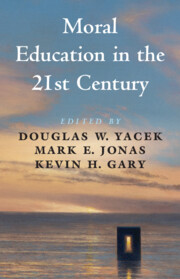Book contents
- Moral Education in the 21st Century
- Moral Education in the 21st Century
- Copyright page
- Contents
- Contributors
- Acknowledgments
- Chapter 1 Why Does Moral Education Matter in the 21st Century?
- Part I Historical Insights for Contemporary Moral Education
- Part II New Approaches to Moral Education
- Part III Responses to Contemporary Moral Problems
- Chapter 13 Moral Education in and for Virtual Spaces
- Chapter 14 The Consumerist Threat to Education and Democracy
- Chapter 15 Moral Education and Deep Disagreement
- Chapter 16 A Character-Based Perspective on Sexual Ethics and Sex Education
- Chapter 17 The Moral Eclipse of Boredom
- Index
- References
Chapter 16 - A Character-Based Perspective on Sexual Ethics and Sex Education
from Part III - Responses to Contemporary Moral Problems
Published online by Cambridge University Press: 01 June 2023
- Moral Education in the 21st Century
- Moral Education in the 21st Century
- Copyright page
- Contents
- Contributors
- Acknowledgments
- Chapter 1 Why Does Moral Education Matter in the 21st Century?
- Part I Historical Insights for Contemporary Moral Education
- Part II New Approaches to Moral Education
- Part III Responses to Contemporary Moral Problems
- Chapter 13 Moral Education in and for Virtual Spaces
- Chapter 14 The Consumerist Threat to Education and Democracy
- Chapter 15 Moral Education and Deep Disagreement
- Chapter 16 A Character-Based Perspective on Sexual Ethics and Sex Education
- Chapter 17 The Moral Eclipse of Boredom
- Index
- References
Summary
In this chapter, I suggest that sexual ethics as it is present in much sex education fails to address some common and formative aspects of many people’s sexual lives. I argue that the foundation of sexual ethics, as part of the ethical life more broadly, is best captured by the metaphor of vision. Any sexual ethics that treats isolated moments of sexual action as the focus of what it means to be sexually moral is insufficient because it ignores the influence that the way people see the world can have on their sexuality (and vice versa). Moral vision is shaped by character, and the way people engage their sexuality is a formative arena for character. So, sex education must address issues of character, and, conversely, attempts at character education must address the power sexuality possesses in the formation of persons.
- Type
- Chapter
- Information
- Moral Education in the 21st Century , pp. 306 - 325Publisher: Cambridge University PressPrint publication year: 2023

